Biology
Biology concepts ? keratin, crystalline form, cornification, regeneration, stem cells
The first time I remember being amazed by biology was when I found out that our fingernails and hair were made of the same thing. My hair is (was) red, but my nails are pretty much transparent and colorless. Hair is thin and is broken easily - you should see my hairbrush. But fingernails and toenails are tough. How can they be made of the same material?
Clubbing of nails as a sign of lung or heart disease was recognized by Hippocrates 2300 years ago. However, clubbing is just an anatomic variation 60% of the time and reflects no underlying disease. What you need to look out for is a change from non-clubbed to clubbed fingers and toes. For a good review, read a 2012 review by Tully et al., you?ll be surprised at what you can learn from your nails.
The cuticle and matrix are white because the melanocytes there are inactive, so there is no pigment produced. The matrix cells divide and the new cells produce a lot of keratin protein. The older cells fill with keratin and die, and the new cells push them out of the way ? this means toward the end of your finger. This is how your nails grow.
So if this is how nails grow, and it is the same for all your nails, why do they grow at different rates? The average rate of growth is about 3.5 mm (0.14 inch) each month (influenced by genetics, age, and health), while toenails grow about half has fast (1.5 mm or 0.06 inch/month). Toenails are thicker and more rigid, does it take longer to make their cornified structure?
There are other things that increase blood flow and nail growth rate. Activity is a big determinant. This is why your fingernails grow faster than your toenails. Muscular movements of the fingers are nearly constant during the day. There is little we do that doesn?t involve moving hands and fingers. All that muscular movement requires oxygen, so blood flow is increased ? and the nails grow faster.
The one determinant I don?t understand - fingernails and toenails on longer digits grow faster. Your index finger?s nail grows faster than your pinky nail. Is it due to usage? Maybe, but then why do longer toenails grow faster- are you using them that much more? My second toe is longer than my big toe, a condition called Morton?s Toe. When I hike, my second toe pushes off the ground last, so maybe it is bearing more weight and doing more work. I can?t test it though, since my second toenails are always running into the front of my boots and the nails are always splitting and falling off.
Takeo, M., Chou, W., Sun, Q., Lee, W., Rabbani, P., Loomis, C., Taketo, M., & Ito, M. (2013). Wnt activation in nail epithelium couples nail growth to digit regeneration Nature DOI: 10.1038/nature12214
Tully AS, Trayes KP, & Studdiford JS (2012). Evaluation of nail abnormalities. American family physician, 85 (8), 779-87 PMID: 22534387
- Human Body Systems
Human Body Systems!Integumentary System: Your body is very prone to damage, and that's why we have this system! This is an organ system that helps protect the body. It has many functions such as to cushion, excrete wastes, regulate temperatures...
- Onychomycosis
Term: onychomycosisLiterally meaning: ?process to fungal nails? Origin: Anc Greek/ï???/onix(=nail) > (gen) ??????/onychos????? /mykes (=mushroom)-????/-osis (=suffix meaning ?condition? or ?state?)Coined/HistoryIn 1853 George Meissner discovered...
- Keratin
Term: keratinLiterally meaning: ?protein of horn?Origin: Anc Greek?????/keras(=horn) > (genitive): ???????/keratosCoined/History The word appeared in literature around 1849 but the first attempt to extract keratins was by John Hoffmeier ...
- Oligonychous (genus)
Term: oligonychous (Banks grass mite or Spruce spider mite) (genus)Literally meaning: ?someone with a few nails?Origin: Anc Greek??????/oligos(=little, small) /ï???/onix(=nail) > /ï?????/onychos (genitive)Coined/History named because it has...
- Onychophagy
Term: onychophagyLiterally meaning: ?process of eating(biting) nails?Origin: Anc Greek/ï???/onix(=nail) > /ï?????/onychos (genitive)+ ????/phago(=to eat)Coined/History (?)DefinitionOnychophagy is the medical term for the habit of nail biting...
Biology
Tough As Nails
Biology concepts ? keratin, crystalline form, cornification, regeneration, stem cells
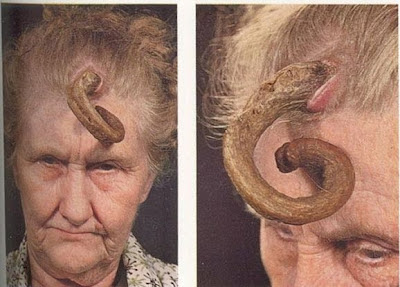 |
Horns are made from keratin, just as are nails, hooves, and hair. Believe it or not, this is a real picture of a condition called a cutaneous horn. It is a tumor of keratin producing cells and can be benign or malignant. They can be removed surgically, which makes me wonder why it is still on her head. Thankfully, the cancerous ones are usually wider than they are long, so this example is probably benign. |
Question of the Day ? How do fingernails grow to be so tough and why do they grow at all?
You use your fingernails everyday, but do you take the time to think about how amazing they are? It?s true that nails are made of a protein called keratin, just like the dead layers of your skin and your hair, but there are differences too.
You?d be surprised to find out what else they do. Your fingers and toes are basically tools; they grasp, push, pull, and gather information. Switching back and forth between gross and fine movements and manipulations requires that your fingers and toes be able to take a lot of punishment, but at the same time maintain themselves for delicate work.
Your nails protect the ends of your fingers and toes during work that could injure them, this keeps them in good shape for the precise things we need to do all day long. But nails are tools as well. They can slip under surfaces and pry them up, and they can act as a hard surface against which you can apply pressure.
This idea of pressure is important for fingers especially. You push down with your fingertip to deliver a precise amount of pressure. The nail provides a flat, rigid surface against which you can measure the pressure and fine tune your work. Nerves abound beneath the nail, you know that from trimming it too short or from having a splinter driven beneath it. Ouch.
But nails have other jobs as well. Did you know that your nails can be good indicators of your overall health? Healthy nails are smooth and have no ridges, although as you get older you may notice more vertical lines. Yellow nails may indicate a malignancy or fluid in your lung spaces (called pleural effusions). Pitted nails might indicate a connective tissue disease (like psoriasis or scleroderma).
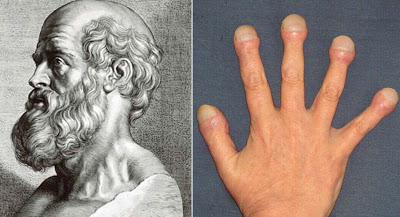 |
Hippocrates was a Greek physician. His importance to the profession of medicine is evident ? new physicians take the Hippocratic Oath, promising first to do no harm. In other words, don?t make things worse. One of his great contributions was to make the connection between an outward sign (clubbing) and an internal disease. In this case, it is usually something wrong in the chest (heart, lungs, upper GI). |
Even more surprising is the job your nails could do for you if you happen to get the tip of your finger or toe chopped off. Unlike starfish and lizards, we don?t generally have the ability to regenerate lost anatomical units or tissues. One exception is the ends of our digits. If you get a portion of your finger cut off, it might grow back, nail and all. But it must be just the tip, some of the nail must be left. If not, all you can do is learn a new way to type.
A 2013 study has shown that nail beds contain stem cells that can grow back the skin, muscle, and even bone of the digit. A specific signaling pathway (Wnt) is key, and when blocked, there is no regeneration. But if you stimulate the Wnt pathway, you can get regeneration beyond the nail bed. This may be huge for future regeneration of lost limbs in humans.
So these are the things your nails do for you, but we haven?t tackled the question of how they can be tough enough to carry out these tasks.
The white semicircle at the base of your nails is the lunula (luna, as in moon). This is where your nails grow from and the mass of cells that produce the nail is called the matrix. Above the matrix, but below the nail is the cuticle. This connects the nail to the finger and hurts like heck if your cut into it while trimming.
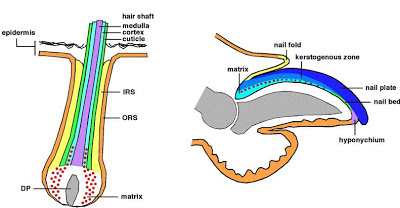 |
The nail and the hair are made from keratin filaments joined together. However, in nails they are wide masses of shorter fibrils and in hairs they are fewer but longer. You can see that both hair and nails have a matrix that produces the keratinizing cells, a cuticle, and the new cells push the older cells along to make the nail or hair longer. |
But our fingernail doesn?t look like individual cells. You are sloughing millions of skin cells each day, but for a nail the dead cells all mass together. Nails only wear away or must be trimmed. Individual cells are not lost. The solidity of the nail comes from the connecting of the dead cells together by junctions between the cells called desmosomes, and by the interlocking of the cells like jigsaw puzzle pieces. But there?s more.
Individual keratin protein filaments also become connected so that the entire mass of keratin becomes one solid structure. This is called cornification, like the stratum corneum (the outer, dead layers) of your skin.
One of the two main forms of keratin in your nails is crystalline keratin, which is rigid, stronger, and has an ordered structure - like a tinker toy cube. Transmitted light is less likely to strike an atom and bounce back when the atoms are all lined up, so this is why many crystalline lattices appear translucent. Precious gems have crystalline forms.
The other keratin is more gel-like and connects the different filaments of crystalline keratin together. There are crosslinks that join glutamine and lysine amino acids in one keratin filament to those in many other filaments; the crosslinking is performed by an enzyme called transglutaminase. There are billions more of these crosslinks in nails as compared to those in dead skin or in hair. This is why nails are much stronger than skin or hair.
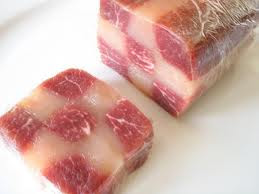 |
Transglutaminase has become a favorite of chefs. They can put different cuts of meat together to forma solid mass. Also called ?meat glue,? transglutaminase can be used to fuse ground or cut meat into something sold as a single piece. Health officials worry about this because it takes outside surfaces that may have been contaminated an puts them on the inside, which can promote bacterial growth. |
So if this is how nails grow, and it is the same for all your nails, why do they grow at different rates? The average rate of growth is about 3.5 mm (0.14 inch) each month (influenced by genetics, age, and health), while toenails grow about half has fast (1.5 mm or 0.06 inch/month). Toenails are thicker and more rigid, does it take longer to make their cornified structure?
Not really. The answer has more to do with the way the body responds to your behaviors and the environment. Live cells in the matrix produce the keratin before the cells die and are joined together as the nail. Being alive means that they need nutrients and oxygen ? things carried in the blood.
Anything that increases the blood flow to an area will allow for faster cell grow and division. This includes heat; your superficial vessels dilate to release excess heat to the environment when your body is in a warmer environment. Dilated vessels hold more blood, so this would mean more growth in those areas. This is why your fingernails grow faster in summer than in winter. They do ? you mean you don?t keep track of how often you trim your nails?
 |
This is pianist Liu Wei from China. He lost his arms at the age of ten when he was electrocuted. I wonder if his toenails now grow faster than mine. It?s amazing what people can do with their feet. Tisha Unarmed is a fantastic video blog where she shows you how she all her daily chores using her feet. You should check it out. |
This idea is reinforced by the fact that fingernails grow faster on your dominant hand. More use, more blood, more growth. For people that have lost the use of the their arms and learn to write, eat, brush their teeth, etc. with their toes ? do their toenails grow faster than their fingernails? If they don?t have fingers, you can?t compare the growth rates of their toenails versus their fingernails, but I bet their toenails grow faster than average.
Blood flow is also increased by trauma; part of the swelling when you whack your thumb with a hammer is due to increased blood flow to the area in an effort to start the healing process. This will also make your nails grow faster. Many scientists believe that everyday uses of fingers, tapping, typing, prying, etc., are all types of microtrauma, so the more you use your fingers, the more blood flow you are inducing.
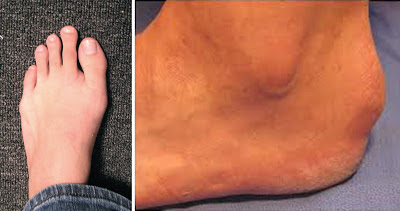 |
On the left is Morton?s toe, also called Greek foot. Is my big toe short, or is my second toe long? On the right, I just decided to show another deformity I have, called Haglund?s deformity. It is a bony bump on my heels, and makes it hard to buy decent hiking boots. Neither picture is my foot by the way; nobody wants to see that mess. |
By the way, since your nails come from the division of live cells, they only grow while you are alive. The old tale about hair and nails growing after you die is untrue. It may have started because other tissues lose water and retract after death, but proteinaceous (meaning made of protein) structures like hair and nails do not contract. Therefore, they may appear to have grown a little bit after death.
Next week - ever wonder why your grass grows back after you mow, but that tree you cut down probably won't? Believe it or not, it is related to your fingernails!
- Human Body Systems
Human Body Systems!Integumentary System: Your body is very prone to damage, and that's why we have this system! This is an organ system that helps protect the body. It has many functions such as to cushion, excrete wastes, regulate temperatures...
- Onychomycosis
Term: onychomycosisLiterally meaning: ?process to fungal nails? Origin: Anc Greek/ï???/onix(=nail) > (gen) ??????/onychos????? /mykes (=mushroom)-????/-osis (=suffix meaning ?condition? or ?state?)Coined/HistoryIn 1853 George Meissner discovered...
- Keratin
Term: keratinLiterally meaning: ?protein of horn?Origin: Anc Greek?????/keras(=horn) > (genitive): ???????/keratosCoined/History The word appeared in literature around 1849 but the first attempt to extract keratins was by John Hoffmeier ...
- Oligonychous (genus)
Term: oligonychous (Banks grass mite or Spruce spider mite) (genus)Literally meaning: ?someone with a few nails?Origin: Anc Greek??????/oligos(=little, small) /ï???/onix(=nail) > /ï?????/onychos (genitive)Coined/History named because it has...
- Onychophagy
Term: onychophagyLiterally meaning: ?process of eating(biting) nails?Origin: Anc Greek/ï???/onix(=nail) > /ï?????/onychos (genitive)+ ????/phago(=to eat)Coined/History (?)DefinitionOnychophagy is the medical term for the habit of nail biting...
